Can You Put Any Rocks In A Rock Tumbler? The answer is no; however, selecting the right rocks is crucial for achieving stunning results, and at rockscapes.net, we guide you through the process. Understanding rock properties and using proper techniques will transform ordinary stones into polished gems for your landscape.
1. What Rocks Are Suitable for Rock Tumbling?
Not all rocks are created equal when it comes to rock tumbling. The best rocks for tumbling are durable, hard, and free of fractures. Rocks with a Mohs hardness of 6 to 8, like jasper, agate, and quartz, are ideal because they can withstand the tumbling process and achieve a high polish.
1.1. Jasper
Jasper is highly recommended due to its durability and ability to achieve a bright luster. It comes in various colors and is relatively inexpensive, making it perfect for beginners. Flint and chert are types of jasper that also work well.
1.2. Agate
Agate is another excellent choice, known for its vibrant colors and interesting patterns. Agate is also inexpensive and polishes to a high shine, making it a popular choice for rock tumbling enthusiasts.
1.3. Petrified Wood
Petrified wood, primarily composed of jasper, is great if free of voids and fractures. The durability and unique patterns of petrified wood make it a fascinating material to tumble.
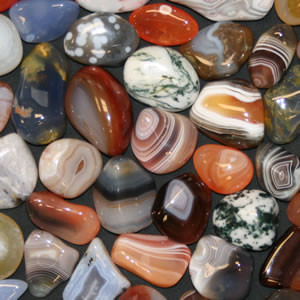 tumbled agates
tumbled agates
Tumbled agates display a variety of colors and patterns after polishing in a rock tumbler.
2. What Rocks Should You Avoid in a Rock Tumbler?
Soft, porous, or fractured rocks are not suitable for rock tumbling. Soft rocks wear down too quickly, while porous rocks trap grit and prevent a good polish. Fractured rocks can break apart during tumbling, damaging other stones in the barrel. Rocks like sandstone, shale, and some types of limestone should be avoided.
3. How Does Mohs Hardness Scale Affect Rock Tumbling?
The Mohs Hardness Scale measures a mineral’s resistance to scratching. Rocks with a hardness between 6 and 8 are ideal for tumbling because they are hard enough to withstand the process but not so hard that they take too long to polish. According to research from Arizona State University’s School of Earth and Space Exploration, rocks with this hardness range achieve the best balance between durability and polishability.
4. Why Is Size Important When Rock Tumbling?
Size matters when rock tumbling, especially with small tumblers. For barrels holding less than two cups of water, rocks should be between 3/8 inch and 1 1/4 inches in size. Larger rocks won’t tumble freely, slowing down the shaping process.
5. What Are the Characteristics of Good Tumbling Rocks?
Good tumbling rocks share several key characteristics:
- Hardness: A Mohs hardness between 6 and 8.
- Density: Dense, without voids or pore spaces.
- Structure: Free of fractures.
- Texture: A smooth texture that doesn’t produce granular debris when rubbed together.
6. How Does Agate Make A Great Rock To Tumble?
Agate is a popular choice for tumbling due to its translucence and variety of colors and patterns. Agate is a microcrystalline variety of quartz formed when groundwater deposits minerals in rock cavities, making it hard and durable.
 eye agate
eye agate
Agates with “eyes” are rare and highly prized by rock tumbling enthusiasts.
7. What Makes Jasper A Good Stone To Tumble?
Jasper is another favorite for its wide range of colors and patterns. It’s an opaque to semi-translucent microcrystalline quartz that accepts a bright polish. Jasper is similar to chert and flint, all being durable and visually appealing.
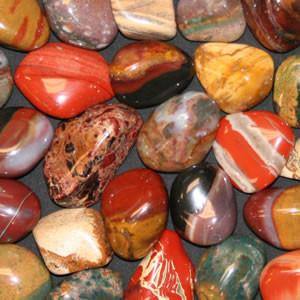 tumbled jasper
tumbled jasper
Tumbled jasper displays a variety of colors and patterns, making it a popular choice.
8. Why Should I Tumble Quartz In A Tumbler?
Quartz, the most abundant mineral in Earth’s crust, is available in many forms suitable for tumbling. Varieties like amethyst, clear quartz, rose quartz, and smoky quartz are popular for their transparency and range of colors.
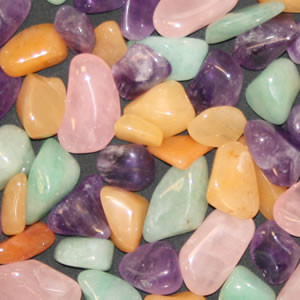 tumbled quartz
tumbled quartz
Tumbled quartz showcases a range of colors, including amethyst, rose quartz, and aventurine.
9. How Is Petrified Wood A Good Tumbling Material?
Petrified wood, formed when woody material is replaced by minerals, is a unique tumbling material. It preserves cell walls, bark, and growth rings, adding a novel element to your collection.
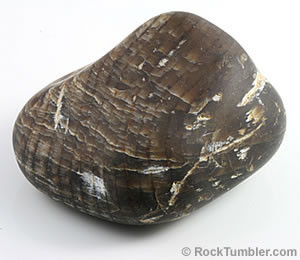 tumbled petrified wood
tumbled petrified wood
Tumbled petrified wood shows distinct wood grain patterns after being polished.
10. Can You Tumble Obsidian In A Tumbler?
Obsidian, a volcanic glass, is challenging to tumble due to its tendency to chip and bruise. However, with careful work and cushioning, you can produce beautiful results. Varieties like snowflake obsidian and mahogany obsidian are popular.
 obsidian rough
obsidian rough
Rough obsidian specimens include mahogany obsidian, Apache tears, and snowflake obsidian.
11. How Do Feldspars Tumble In A Rock Tumbler?
Feldspars like amazonite, moonstone, labradorite, and sunstone can be tumbled, but they require extra care. Their cleavage planes make them prone to breaking, so proper barrel filling and cushioning with plastic pellets or ceramic media are essential.
12. Can You Tumble Glass In A Rock Tumbler?
Yes, you can tumble glass to create sea glass-like pieces for craft projects. Tumbled glass is popular for jewelry making and decorative accents in potted plants.
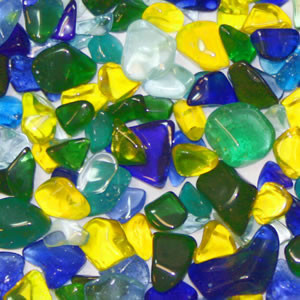 tumbled glass
tumbled glass
Tumbled glass can be used in various craft projects, such as jewelry making and decorative accents.
13. What Other Rocks Can Be Tumbled?
Other rocks that can be tumbled, though less frequently, include hematite, lapis lazuli, lepidolite, malachite, mookaite, prehnite, rhodonite, sodalite, and zoisite. Howlite and magnesite are also tumbled but are often dyed to resemble turquoise.
14. Step-by-Step Guide to Rock Tumbling
Rock tumbling involves several stages, each requiring specific grit and duration. Here’s a comprehensive guide:
14.1. Stage 1: Coarse Grind (60/90 Grit)
- Purpose: To shape the rocks and remove rough edges.
- Duration: 7-10 days.
- Instructions: Fill the tumbler barrel 2/3 to 3/4 full with rocks. Add coarse grit (60/90) according to the tumbler’s instructions. Add water until the rocks are just covered. Tumble for 7-10 days, checking the slurry’s consistency periodically. The slurry should be thick but not pasty.
14.2. Stage 2: Medium Grind (120/220 Grit)
- Purpose: To smooth the surfaces and prepare for finer grits.
- Duration: 7 days.
- Instructions: Clean the barrel and rocks thoroughly to remove all traces of the coarse grit. Add medium grit (120/220) and water, ensuring the rocks are covered. Tumble for 7 days, checking the slurry.
14.3. Stage 3: Fine Grind (500/F Grit)
- Purpose: To further smooth the surfaces and remove any remaining scratches.
- Duration: 7 days.
- Instructions: Clean the barrel and rocks again. Add fine grit (500/F) and water. Tumble for another 7 days, checking the slurry.
14.4. Stage 4: Polish (1000/AO or Cerium Oxide)
- Purpose: To achieve a high-gloss finish.
- Duration: 7-10 days.
- Instructions: Thoroughly clean the barrel and rocks. Add polishing compound (1000/AO or Cerium Oxide) and water. Tumble for 7-10 days, checking the slurry. For the best results, consider using a burnishing step.
14.5. Burnishing (Optional)
- Purpose: To enhance the shine and remove residue.
- Duration: 24 hours.
- Instructions: After polishing, clean the rocks and barrel. Add a small amount of borax or soap flakes and water. Tumble for 24 hours to burnish the stones.
15. What Equipment Do I Need for Rock Tumbling?
To start rock tumbling, you’ll need:
- A Rock Tumbler: Choose a rotary or vibratory tumbler based on your needs.
- Grits: Coarse (60/90), medium (120/220), fine (500/F), and polish (1000/AO or Cerium Oxide).
- Ceramic Media or Plastic Pellets: For cushioning and improving the tumbling action.
- A Sieve: To wash away grit between stages.
- Buckets: For cleaning rocks and equipment.
16. How To Maintain Your Rock Tumbler?
Proper maintenance ensures your rock tumbler lasts longer and performs efficiently. Here are some tips:
- Clean the Barrel: After each stage, thoroughly clean the barrel to remove grit and debris.
- Inspect the Belt: Check the drive belt regularly for wear and tear. Replace if necessary.
- Lubricate Moving Parts: Keep moving parts lubricated to reduce friction and wear.
- Store Properly: When not in use, store the tumbler in a clean, dry place.
17. Can You Use Ceramic Media or Plastic Pellets to Tumble Rocks?
Using ceramic media or plastic pellets in your rock tumbler offers several benefits:
- Cushioning: They help cushion the rocks, preventing chipping and bruising, especially with softer materials like obsidian and feldspars.
- Improved Tumbling Action: They ensure that all rocks in the barrel are tumbled evenly.
- Grit Distribution: They help distribute the grit more evenly, improving the overall polishing process.
- Volume Maintenance: They help maintain a consistent volume in the barrel, which is crucial for optimal tumbling.
18. Troubleshooting Common Rock Tumbling Problems
Even with the best preparation, you might encounter issues. Here are some common problems and solutions:
- Rocks Not Polishing: Ensure you’re using the correct grit sequence and thoroughly cleaning between stages.
- Rocks Breaking: Use cushioning media and avoid tumbling fractured rocks.
- Dull Finish: Try a burnishing step or use a higher-quality polishing compound.
- Uneven Wear: Ensure the barrel is filled to the correct level and the rocks are properly sized.
19. Rock Tumbling Safety Tips
Safety should always be a priority. Here are some essential tips:
- Wear a Mask: When handling dry grit and polishing compounds, wear a dust mask to avoid inhaling fine particles.
- Wear Gloves: Protect your hands from abrasion by wearing gloves.
- Work in a Well-Ventilated Area: Ensure good ventilation to avoid inhaling dust and fumes.
- Keep Away from Children and Pets: Store tumbling equipment and materials out of reach.
- Dispose of Waste Properly: Dispose of used grit and slurry in an environmentally responsible manner.
20. Where To Find Rocks for Tumbling in the USA
Finding rocks for tumbling can be an exciting adventure. Here are some top locations in the USA:
20.1. Arizona
Arizona is a treasure trove for rock collectors, offering a wide variety of materials like agate, jasper, and petrified wood. Popular spots include:
- Round Mountain: Known for its abundant agate and jasper.
- Holbrook Petrified Forest: Famous for colorful petrified wood.
20.2. California
California’s diverse geology makes it a great place to find tumbling rocks. Look for:
- Mojave Desert: Agate, jasper, and chalcedony can be found here.
- Coastal Areas: Beachcombing can yield interesting finds like sea glass and pebbles.
20.3. Oregon
Oregon is renowned for its beautiful agates and jaspers, particularly along the coast. Check out:
- Ona Beach: Known for its agate and jasper deposits.
- Richardson’s Rock Ranch: A popular spot for collecting thundereggs and other materials.
20.4. Texas
Texas offers a variety of rocks, including petrified wood and agate. Consider visiting:
- Big Bend National Park: Petrified wood and agate can be found in this area.
- Various Riverbeds: Agate and other materials are often found in riverbeds throughout Texas.
20.5. Montana
Montana is famous for its sapphires and agates. Explore:
- Missouri River: Known for its agate deposits.
- Gem Mountain Sapphire Mine: You can dig for sapphires and other gemstones.
21. How to Find Local Rockhounding Groups and Clubs
Joining a local rockhounding group or club can enhance your rock tumbling experience. These groups offer:
- Field Trips: Organized trips to prime rock-collecting locations.
- Expert Advice: Learn from experienced rockhounds.
- Networking: Connect with other enthusiasts.
- Educational Resources: Access to workshops and seminars.
To find local groups, search online for “rockhounding clubs near me” or check with local gem and mineral societies.
22. The Best Types of Rocks for Polishing
Some rocks are simply better suited for achieving a high-quality polish. These include:
- Agate: Known for its ability to take a brilliant polish.
- Jasper: Polishes easily and comes in a variety of colors.
- Quartz: Produces a clear, glossy finish.
- Petrified Wood: Can be polished to a beautiful shine, highlighting its unique patterns.
23. The Importance of Proper Grit Selection
Using the correct grit at each stage is crucial for achieving the best results. Here’s why:
- Coarse Grit: Shapes the rocks and removes rough edges.
- Medium Grit: Smoothes the surfaces and prepares for finer grits.
- Fine Grit: Further smooths the surfaces and removes scratches.
- Polish: Achieves the final high-gloss finish.
Using the wrong grit or skipping stages can result in poorly polished stones.
24. Rotary vs. Vibratory Tumblers: Which Is Better?
Choosing between rotary and vibratory tumblers depends on your specific needs:
- Rotary Tumblers: These are the most common type. They are great for shaping rocks and can handle larger loads.
- Vibratory Tumblers: These are faster and more efficient for polishing. They are less aggressive and better for delicate materials.
Rotary tumblers are typically used for the initial shaping stages, while vibratory tumblers are often preferred for the final polishing stages.
25. Explore the Beauty of Landscape Rocks with Rockscapes.net
Discover the beauty of landscape rocks and transform your outdoor spaces with rockscapes.net. Our website provides inspiration, information, and resources for creating stunning rock gardens, pathways, and water features.
25.1. Ideas for incorporating tumbled rocks into your landscape
Tumbled rocks can add a unique touch to your landscape:
- Pathways: Use tumbled rocks to create decorative pathways.
- Rock Gardens: Add tumbled stones as accents in rock gardens.
- Water Features: Incorporate polished rocks into water features for a stunning effect.
- Potted Plants: Use tumbled glass or rocks as ground cover in potted plants.
25.2. Tips for Choosing the Right Rocks for Your Landscape
Choosing the right rocks for your landscape involves considering:
- Color and Texture: Select rocks that complement your home and garden.
- Size and Shape: Choose rocks that fit the scale of your landscape.
- Durability: Opt for durable rocks that can withstand the elements.
- Local Availability: Use locally sourced rocks to create a natural look.
Address: 1151 S Forest Ave, Tempe, AZ 85281, United States.
Phone: +1 (480) 965-9011.
Website: rockscapes.net.
25.3. Connect with Experts at Rockscapes.net
Transform your rock tumbling hobby into stunning landscape designs with the expertise and resources available at rockscapes.net. Dive into detailed guides, explore a variety of rock types, and find the inspiration you need to elevate your outdoor spaces.
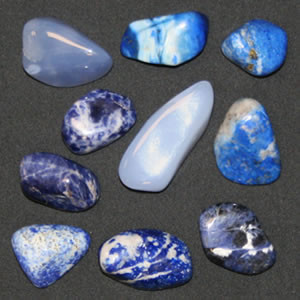 blue tumbled stones
blue tumbled stones
Blue tumbled stones like sodalite and lapis lazuli are popular for their unique color.
FAQ: Rock Tumbling Questions Answered
26.1. Can I put any rocks in a rock tumbler?
No, you cannot put any rocks in a rock tumbler and expect good results; the best rocks are hard, dense, and free of fractures. Softer or porous rocks will not polish well.
26.2. What is the best grit to start with in a rock tumbler?
The best grit to start with in a rock tumbler is coarse grit (60/90) to shape the rocks and remove rough edges. This initial step is crucial for achieving a smooth, polished finish.
26.3. How long does it take to tumble rocks?
It typically takes four to six weeks to tumble rocks, with each stage (coarse grind, medium grind, fine grind, and polish) lasting about 7-10 days. The duration can vary based on the type of rock and the tumbler being used.
26.4. Can I mix different types of rocks in a rock tumbler?
It is not recommended to mix different types of rocks in a rock tumbler, especially if they have varying hardness levels. Softer rocks can break down and damage the harder ones.
26.5. What is the Mohs hardness scale, and why is it important?
The Mohs hardness scale measures a mineral’s resistance to scratching. It is important in rock tumbling because rocks with a hardness between 6 and 8 are ideal for achieving a good polish.
26.6. How do I clean rocks between stages in a rock tumbler?
To clean rocks between stages in a rock tumbler, thoroughly rinse them with water and use a sieve to remove any remaining grit or debris. A clean barrel and rocks are essential for the next stage.
26.7. What is burnishing, and why should I do it?
Burnishing is an optional final step in rock tumbling that enhances the shine and removes residue. Tumble the polished stones with borax or soap flakes and water for about 24 hours to achieve a superior finish.
26.8. Can I tumble glass in a rock tumbler?
Yes, you can tumble glass in a rock tumbler to create sea glass-like pieces for craft projects. Proper cushioning and care are necessary to prevent excessive chipping.
26.9. What are some common mistakes to avoid when rock tumbling?
Common mistakes to avoid when rock tumbling include using the wrong grit sequence, not cleaning rocks and the barrel between stages, overloading the tumbler, and using rocks that are too soft or fractured.
26.10. Where can I find more information and resources about rock tumbling?
You can find more information and resources about rock tumbling at rockscapes.net. Explore detailed guides, rock types, and inspiration for transforming your outdoor spaces. Connect with experts and discover the beauty of landscape rocks today.
In Conclusion
Choosing the right rocks is essential for successful rock tumbling. Focus on hard, dense, and fracture-free materials like jasper, agate, and quartz for the best results.
